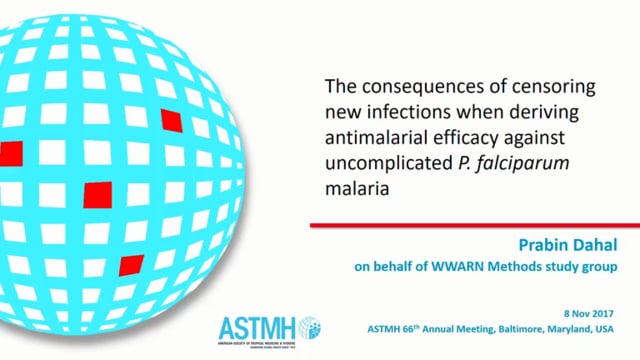ASTMH 2017, Prabin Dahal: “The consequences of censoring new infections when deriving antimalarial efficacy against uncomplicated P. falciparum malaria”
Collaborator(s): WorldWide Antimalarial Resistance Network (WWARN), United Kingdom
Published: 08/11/2017
In collaboration with ASTMH, Image Audiovisuals, and session presenters, MESA brings you this webcast from the 66th ASTMH annual meeting in Baltimore, November 2017
Title: “The consequences of censoring new infections when deriving antimalarial efficacy against uncomplicated P. falciparum malaria”
Speaker: Prabin Dahal, WorldWide Antimalarial Resistance Network
Session information:
Symposium 0119: “Malaria: Advances in Modeling and Technology for Malaria”
Wednesday, 8 November, 8:00 – 9:45 AM, Convention Center – Ballroom I (Level 400)
Abstract:
The primary endpoint in efficacy trials of uncomplicated P. falciparum is polymerase chain reaction adjusted failure defined as the reappearance of the same parasite which caused the initial infection (recrudescence). Competing risk event (CE) of a new infection can be observed during the follow-up. These are censored in Kaplan Meier (K-M) analysis, the currently recommended statistical method for deriving failure. In the presence of CE, K-M is known to result in an overestimate of cumulative failure compared to Cumulative Incidence Function (CIF). The overall aim of this work is to quantify the bias due to the use of K-M in estimating cumulative failure in studies with artemisinin combination therapies (ACTs) in uncomplicated P. falciparum. Cumulative failure for recrudescence were derived using: 1 minus K-M estimate where competing events were censored, and CIF which accounts for competing event by still maintaining them in the risk set. The discrepancy between the two estimates was expressed as absolute and relative difference. The impact of study duration, proportion of recrudescences and new infections on the difference was investigated. Data on 31379 patients treated with ACTs from 87 trials (1996-2014) in Africa, Asia and S.America were available. There were 682 (2.2%) recrudescences and 3,738 (11.9%) new infections as classified by study investigators. A total of 85% (199/233) of treatment arms reported at least one new infection. On absolute scale, the overestimation using K-M was small with a median of 0 [range: 0- 0.06]. The median relative overestimation was: 2.4% [range: 0- 67.1%] and this increased with study duration: 0.6% on day28, 4.7% on day42, and 9.3% on day63. The relative overestimation was correlated with the proportion of new infections which becomes greater with longer follow-up (correlation 0.67 [95% CI 0.61-0.73]). Censoring new infections in the K-M analysis led to a marginal overestimation of cumulative failure of recrudescence which increased with study duration. The CIF approach is ideally suited to derive cumulative failure estimate when the observed proportion of new infection is high.
THEMES: Drug Resistance | Drug-based Strategies



